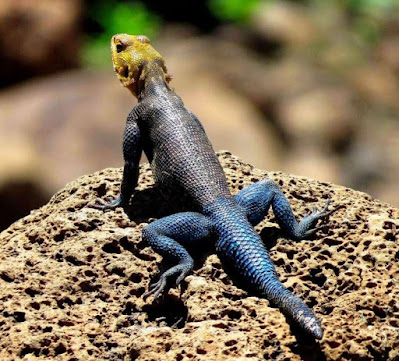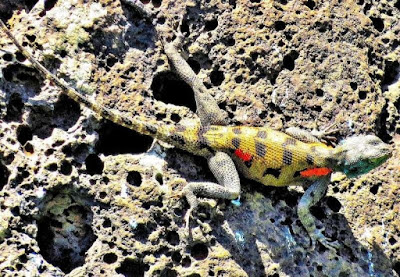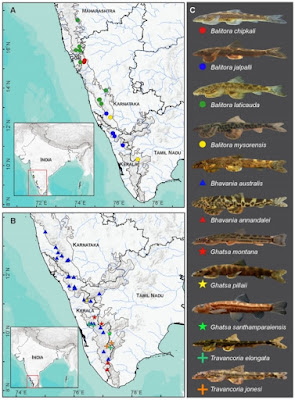[Most Recent Entries] [Calendar View]
Thursday, February 4th, 2021
| Time | Event | ||
| 2:40a | [Herpetology • 2021] Agama wachirae • A New Species of the Agama lionotus Boulenger, 1896 Complex (Squamata: Agamidae) from northern Kenya
Abstract Kenya has a high diversity of agamid lizards and the arid northern frontier area has the highest species richness. Among the Kenyan agama species, Agama lionotus has the widest distribution, occurring from sea level to inland areas in both dry and moist savanna as well as desert areas. This species mostly prefers rocky areas, both in granitic/metamorphic and volcanic rocks, although it also makes use of tree crevices as well as man-made structures. Recently in Marsabit, northern Kenya, a small-sized agama species, distinct from A. lionotus, was collected within a rocky lava desert area. This new species is characterized by its small size (mean SVL ~83 mm) as compared to typical A. lionotus (mean SVL ~120 mm). Past studies have shown the value of adult male throat coloration for the identification of species within the A. lionotus complex. Herein we also highlight female dorsal color pattern, which is a key character for distinguishing the new species from others in the group, including the similar A. hulbertorum. As in A. lionotus, displaying adult males have an orange to yellow head, a vertebral stripe, a bluish body coloration and an annulated white/blue tail. But the most diagnostic character is the coloration of females and non-displaying males, which exhibit a series of regular pairs of dark spots along the vertebrae as far posterior as the tail base. In addition, females have a pair of elongated orange or yellow marks on the shoulders and another on the dorsolateral margins of the abdomen. This study shows that more cryptic species in the Agama lionotus complex may still await discovery. The new species was found inhabiting dark desert lava rocks but should additionally be present in suitably similar sites in the northern frontier area. This underscores the need to re-examine populations of Agama lionotus from different microhabitats in this country. Keywords: Reptilia, Agama lionotus complex, Agamidae, cryptic species, rock outcrops, Marsabit Agama wachirae Marsabit Rock Agama Patrick K. Malonza, Stephen Spawls, Brian Finch and Aaron M. Bauer. 2021. A New of Species of the Agama lionotus Boulenger, 1896 Complex (Squamata: Agamidae) from northern Kenya. Zootaxa. 4920(4); 543–553. DOI: 10.11646/zootaxa.4920.4.5 | ||
| 8:48a | [Ichthyology • 2021] Phylogenetic Position and Relationships of Mountain Loaches (Teleostei: Balitoridae) of the Western Ghats as revealed by CO1 Sequences
Abstract The teleostean family Balitoridae comprises small-sized freshwater fishes adapted to swift-flowing torrential mountain streams in South and South-East Asia. Little is known about their molecular phylogenetics and evolutionary biogeography, and much of the scientific literature that references them is focused on morphological taxonomy. In this paper, we generate CO1 sequences for the endemic balitorid lineages of the Western Ghats (WG) Hotspot in India, particularly for the endemic genera, Bhavania, Ghatsa and Travancoria. Integration of these data into a phylogeny revealed that the endemic WG genera together form a well-supported monophyletic clade that shows, subject to our limited taxon sampling, a sister-group relationship to the Southeast Asian genus Pseudohomaloptera. Three WG endemic species of the genus Balitora, namely B. chipkali, B. jalpalli and B. laticauda, though morphologically distinct, have low genetic divergence and barcode gap, suggestive of recent speciation. Interestingly, a fourth WG endemic, B. mysorensis, formed a clade with two species of Balitora from Eastern-Himalaya and Indo-Burma. We also show that all available CO1 sequences assigned to WG endemic balitorid genera in GenBank are misidentifications, and provide diagnostic characters for the accurate identification of these taxa in the future. Keywords: Pisces, freshwater fish, hill-stream loaches, mitochondrial DNA, peninsular India Arya Sidharthan, Rajeev Raghavan, V. K. Anoop, Unmesh Katwate and Neelesh Dahanukar. 2021. Phylogenetic Position and Relationships of Mountain Loaches (Teleostei: Balitoridae) of the Western Ghats as revealed by CO1 Sequences. Zootaxa. 4926(1); 79–92. DOI: 10.11646/zootaxa.4926.1.5 |
| << Previous Day |
2021/02/04 [Calendar] |
Next Day >> |




